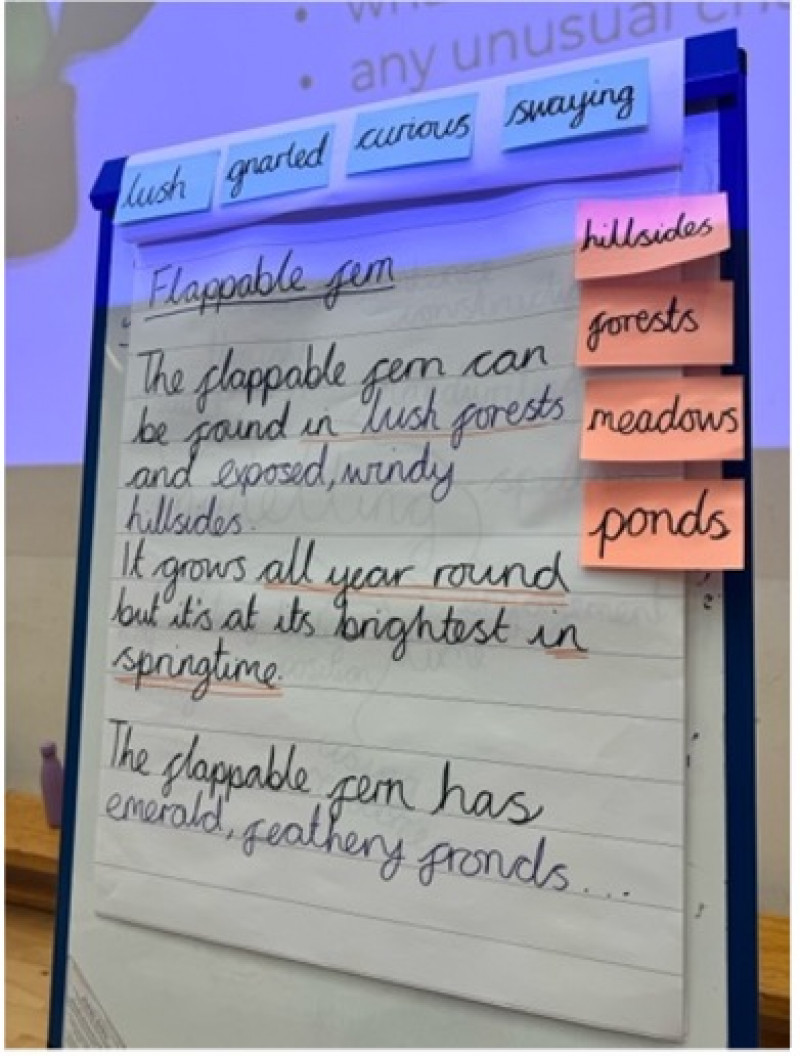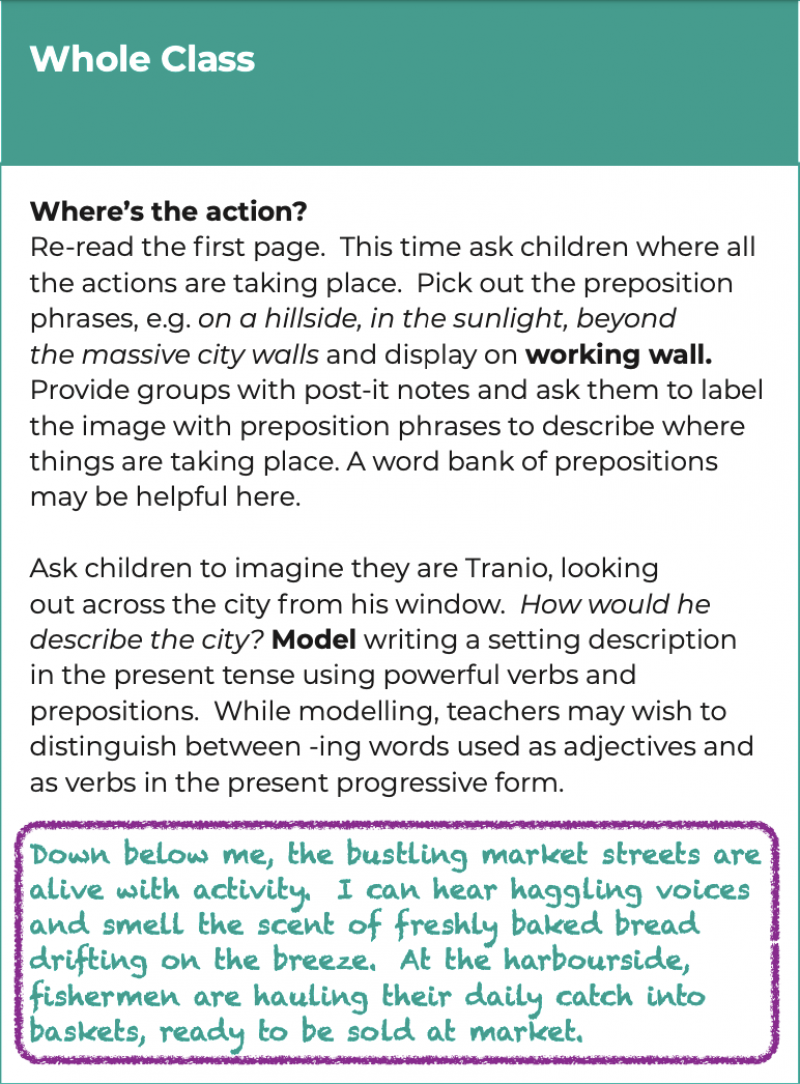Posted on: 25/10/2024
If you were to play a game of Literacy Tree bingo of the key terms we commonly use, you’d be placing a safe bet if you chose ‘live modelling’ as one of your options. We talk about live modelling a lot, and it has relevance for every aspect of our curriculum offer. Within our resources, we use ‘shared writing’ as an umbrella term to indicate modelling, scribing, supporting and editing – all of these have their place and we encourage teachers to choose the approach most appropriate for supporting the children’s writing at that particular point of learning. For the purposes of this blog we will be diving into the specifics of live modelling, with the teacher demonstrating the writing process live in front of the class.
We should make no bones about it - live modelling is challenging. It’s no surprise that within our consultancy work, it is often the area teachers request the most support in. It can feel exposing and high stakes, and for anyone feeling shaky in subject knowledge, that pressure can feel off-putting. The cognitive load for us as teachers is high: we’re thinking about our positioning in the classroom; the skills building up to this point; making sure our children aren’t overwhelmed; ensuring all children are engaged and focussed; applying accurate subject knowledge; handwriting; fitting everything on the page; audience, purpose and form; vocabulary; spelling; timings… the list goes on. It’s no wonder it’s hard work! So with this in mind, here are some top tips to support you with live modelling success.
To support you, our Writing Roots contain examples of Shared Writing (easily identifiable by their green font), but it is important that these are used as a springboard and starting point to inform your own live modelling, rather than using a screenshot of them on an IWB to unpick. Live modelling is focussed on process rather than outcome and children need to see the craft of creation rather than the final product. We often say that shared writing and live modelling are like the ‘how to’ cake baking tutorial, as opposed to simply seeing an exquisitely baked masterpiece, or ‘WAGOLL’ at the end of the process and trying to replicate it. Modelling writing live exposes children to the intricate thinking and decision-making processes involved in writing, supporting children to think like authors and hold audience and purpose at the forefront of their minds so they are always considering the who and the why. It breaks down the writing process into more manageable chunks to support their cognitive load and allows you the opportunity to model not just the physical act of writing but how to use resources around you like working walls and prior learning to support you.


While we know that some schools and teachers use the term ‘flipcharts’ to refer to their IWB slides or powerpoints, when we talk about flipcharts, be assured we are always talking about the physical paper kind. Every classroom needs a flipchart, flipchart paper and coloured pens and we’d go as far as to say you simply cannot teach writing effectively without them. If you have a visualiser in your classroom, these can also be used to model writing live into a book (indeed these can be really helpful for presentation purposes as children are seeing a direct example of their book layout on screen). The downside of this however, is not being able to easily share these models so they are visible on the working wall after the point of writing – this is vital for children to be able to refer back to. Different coloured pens can be used to draw attention to specific success criteria or focus points, and having a specific colour for editing (ideally the same colour that your children use in their own editing) can be helpful in modelling the editing process as you write. Having your year group’s Appendix 2 or Steps in Progression document to hand (perhaps behind your flipchart) is also useful.
The examples of shared writing embedded in the Writing Roots include specific year group objectives and application of skills from throughout the sequence. However, it is important to note that these are designed to be a springboard for you to inform your own shared writes and models. You are the expert in your children and you are the one who knows their starting points, challenges and misconceptions. When planning, focus in on the shared write examples and ask yourself the following questions:
· What prior knowledge are my children coming with?
· What are the misconceptions I have picked up through my marking and feedback?
· Which skills do I want to focus on?
Live modelling doesn’t mean you have to make it up on the spot. Spending time in your planning sessions really unpicking the suggested shared writes and crafting your own takes on them, tailored to the needs of your children, will really pay off. The changes you make don’t have to stay in your head!

Noting them down on your planning or on a post-it note and sticking this to the back of your flipchart so you aren’t having to remember all the elements off the top of your head can be really useful. It may be, at times, that you stick with the suggestion word for word – even so, having this printed off behind your flipchart and ‘live’ modelling from this is hugely valuable.
With live modelling, it can be really tempting to write the first sentence or two onto your flipchart in advance, perhaps while the children are out at break just to ‘get you started’. While on occasions this is entirely appropriate to do depending on what you want the focus point of your shared write to be, it is important that children also see you starting with a blank page, since this is what we expect them to do. Embracing the ‘blank page panic’ and modelling aloud the thought process of how to start a piece of writing and use the tools around you to help you cannot be understated, demonstrating the use of the working wall and thinking aloud to remind ourselves of audience and purpose and the key skills we have been practising.
Be mindful of the amount of time spent on live modelling within a session, remembering the rule that generally speaking, the attention span of the average child equates to a minute per year of their age! It can be easy as teachers to get drawn into our own live models and want to keep going – after all, we’re excited authors! Have a clear point in mind where you will stop your model and remember that the suggested shared writes don’t necessarily mean you need to model the whole thing!
We hope these top tips support you with tackling the challenges of live modelling. If you’d like further support in this area, do sign up to our Spring pedagogy workshop with Jen here around the use of Shared Writing in Writing Roots to explore this and boost your confidence further.
Posted in: Curriculum | Classroom | Shared Writing